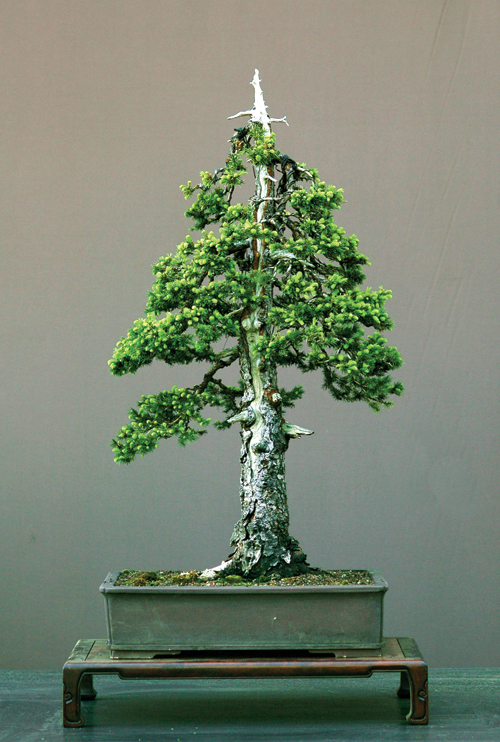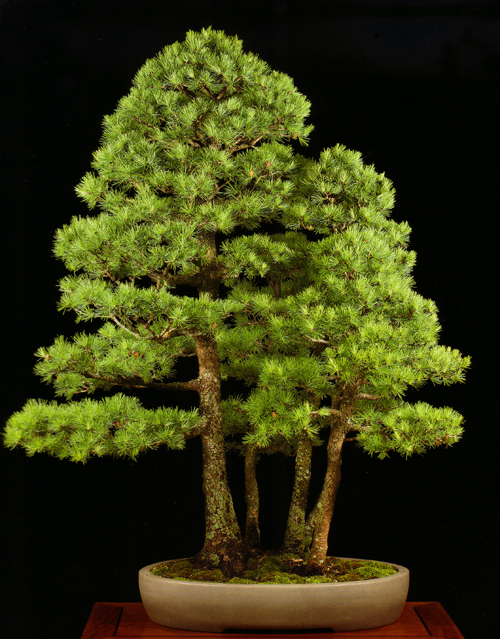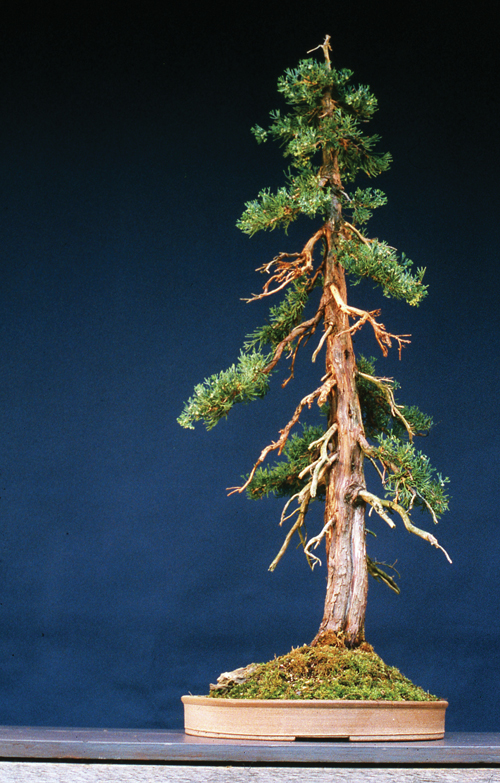
A naturalistic Norway spruce (Picea abies) by Walter Pall (from Bonsai Today issue 106). This tree was awarded third place overall in the Bonsai Today/Art of Bonsai 2006 photo contest. Walter also won first and second place in the overall category.
The Naturalistic Bonsai Movement?
In the expanding galaxy of accomplished Western bonsai artists, Walter Pall’s bonsai skills and dedication to teaching and promoting the art of bonsai make him one of the brightest stars. Walter is also one of the most prominent proponents of what could be called the Naturalistic Bonsai Movement (or something like that).
In our last Great Debate post, I promised you more from Walter on the topic. The quotes below by Walter are from an article entitled A Naturalistic Scot’s Pine that appeared in Bonsai Today issue 104 (out of print).
The other two photos in this post are NOT Walter’s trees. They are rather, my idea of two worthy examples of naturalistic bonsai by other artists.

This sinuous root American larch (Larix larcina) by Harvey Carapella, appears in North American Bonsai (American Bonsai Society; compiled and edited by Martin Schmalenberg). At first glance you might think it has only four trunks (were it so, would it be a problem?), but if you look closely, you can see a small piece of the fifth trunk just to the left of the trunk on the right.
Quoting Walter Pall
We started this quote from Walter in our previous Great Debate post, but left it hanging. So here’s the whole paragraph: “A traditional bonsai is ideal; it is abstract. A naturalistic bonsai is realistic, but never totally realistic. There’s always a certain degree of abstraction. But never going as far as many modern bonsai, which are very groomed, very refined, and often look almost unreal. They certainly look like a human being, not nature, has made them. Naturalistic bonsai is the opposite of this development (which has gone a bit too far in many cases, in my opinion)”
Walter goes on to say… “A lot of people think they understand this, and let nature do the styling of their tree in a pot. They think that naturalistic styling is just letting a tree grow and styling here and there. This is wrong. It is called naturalistic because it NOT natural. The trick is NOT to leave the stock as is and let nature do the styling. ‘Naturalistic’ means that the end result, the finished tree in a pot, conveys the feeling of an impressive natural tree that has not been touched by man. It does not matter how this is achieved, but in most cases it is done very artificially – not by nature!”
The question of method
“Naturalistic bonsai has nothing to do with method, but only with result. Clip-and-grow without using wire is an old method for creating bonsai. Many think this is naturalistic bonsai styling. It is not, but it could be. A hedge is created by clip-and-grow method; and it can hardly be called naturalistic…”
Not an excuse for lazy people
Naturalistic is not an excuse for lazy people. It is not about untidy looking trees. It is not a shortcut. I think it is even more labor intensive than traditional styling…”

Ground juniper (Juniperus horizontalis) by Nick Lenz, from Bonsai from the Wild 2nd ed. (Stone Lantern Publishing).
Enough for now
That’s enough for now. We’ll revisit the topic later. Meanwhile, I look forward to your comments. Here are links to the two previous posts on the Great Debate, in case you missed them: One & two.
Ok I’ll jump in; my thoughts are if a bonsai composition is classical bonsai or naturalistic bonsai, it must meet a few criteria. It needs to be designed well, have balance and tell a story. The main quality of a work of art is in its expression, not its technique. Beginning students of bonsai should do much studying of composition and mature artists should continue to learn their craft and their visual skills.
If a bonsai composition of high skill has no meaning other than its outer appearance it is a hollow expression. A well groomed classical bonsai takes knowledge of horticulture, design and balance. A naturalistic bonsai takes the same talent. They are both premeditated and calculated. Advanced artists will have a picture in their minds eye rather quickly where they want to go with their composition. These compositions you show here are classical examples of creative artists. They are capable of creating classical or natural bonsai. They have simply taken the rules/guidelines and muted them. This allows greater freedom which lends itself to more creative compositions. If it holds your attention, makes you feel good and tells a story, who cares what the classification is. Good bonsai is good bonsai.
Patrick,
Thanks for your well thought out comments (thanks to others too). You’ve pretty much expressed my views. It’s more about appreciating the artistry, feeling and story than taking sides. Painting provides a good analogy; we don’t have to reject Rembrant to appreciate Miro.